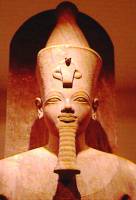
| Amenhotep III Nebmaatre The Height of the 18th Dynasty |
|
 |
Amenhotep III (1386-1349 BC) was a pharaoh from the 18th Dynasty (1570-1293 BC) who was a prolific builder and a relatively benevolent ruler. His reign lasted almost 40 years and was both stable and prosperous. He took the throne of Egypt at the early age of 12. His great-grandfather was Thutmosis III. His parents were Thutmosis IV and Queen Mutemwiya. He had many wives, one chief wife was Tiy, daughter of Yuya and Tuya (whose mummies are among the best preserved in Egypt). Amenhotep had two sons, The older died leaving Amenhotep IV to succeed to the throne. Amenhotep IV, after succeeding to the throne would later change his name to Akhenaten! Amenhotep III's reign was one of relative peace and the prosperity during his time was due to more to international trade and a strong gold supply, not from conquest and expansionism. He did lead campaigns, but mainly earlier on in his reign. Amenhotep built many splendid temples and statuary, including many large lifelike statues of himself.
Amenhotep died in his 39th year of his reign from some undefined illness, at the age of 50. He had lived to celebrate two Sed Festivals. His tomb has been identified in the Valley of The Kings as tomb KV22, which is decorated with a version of the "Book of What Is In The Underworld". His mummy is believed to have been recovered in the Royal cache that was found in the tomb of Amenhotep II. By Andrew Bayuk |
BACK
to Famous Pharaohs IndexGuardian's Web
Guardian's Egypt
Copyright © 1995-2003 Andrew Bayuk
All Rights Reserved